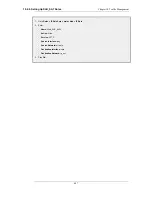
•
If this is not the first cluster in a network then the Cluster ID must be changed for the cluster so
that it is unique (the default value is 0). The Cluster ID determines that the MAC address for the
cluster is unique.
•
Enabling the advanced setting Use Unique Share MAC is recommended so that each interface
has its own MAC address. If this is not enabled, interfaces share a MAC address and this can
confuse some third party switches.
•
Make sure that the advanced setting High Buffers is set to be automatic for both units in the
cluster. This setting determines how memory is allocated by NetDefendOS for handling
increasing numbers of connections. A hardware restart is required for a change in this setting to
take effect.
Where a cluster has a very high number (for example, tens of thousands) of simultaneous
connections then it may be necessary to set a high value for this instead of using automatic. A
very high value for High Buffers can suit situations with large numbers of connections but can
have the disadvantage of increasing throughput latency.
11.3.4. Unique Shared Mac Addresses
For HA setup, NetDefendOS provides the advanced option Use Unique Shared MAC Address. By
default, this is enabled and in most configurations it should not need to be disabled.
Enabling a Unique Shared MAC Address
The effect of enabling this setting is that a single, unique MAC address will be used for each pair of
matching hardware interfaces so that, for example, the lan1 interface on the master unit will appear
to have the same MAC address as the lan1 interface on the slave unit.
Problem Diagnosis
An HA cluster will function if this setting is disabled but can cause problems with a limited number
of switch types where the switch uses a shared ARP table. Such problems can be hard to diagnose
which is why it is best to always have the setting enabled.
With Dissimilar Hardware Units
In one situation, this setting should be disabled and that is when an HA cluster is set up using
non-matching hardware. In order to function correctly, unique shared MAC addresses should not be
used.
11.3.4. Unique Shared Mac Addresses
Chapter 11. High Availability
497
Summary of Contents for DFL-1600 - Security Appliance
Page 27: ...1 3 NetDefendOS State Engine Packet Flow Chapter 1 NetDefendOS Overview 27 ...
Page 79: ...2 7 3 Restore to Factory Defaults Chapter 2 Management and Maintenance 79 ...
Page 146: ...3 9 DNS Chapter 3 Fundamentals 146 ...
Page 227: ...4 7 5 Advanced Settings for Transparent Mode Chapter 4 Routing 227 ...
Page 241: ...5 4 IP Pools Chapter 5 DHCP Services 241 ...
Page 339: ...6 7 Blacklisting Hosts and Networks Chapter 6 Security Mechanisms 339 ...
Page 360: ...7 4 7 SAT and FwdFast Rules Chapter 7 Address Translation 360 ...
Page 382: ...8 3 Customizing HTML Pages Chapter 8 User Authentication 382 ...
Page 386: ... The TLS ALG 9 1 5 The TLS Alternative for VPN Chapter 9 VPN 386 ...
Page 439: ...Figure 9 3 PPTP Client Usage 9 5 4 PPTP L2TP Clients Chapter 9 VPN 439 ...
Page 450: ...9 7 6 Specific Symptoms Chapter 9 VPN 450 ...
Page 488: ...10 4 6 Setting Up SLB_SAT Rules Chapter 10 Traffic Management 488 ...
Page 503: ...11 6 HA Advanced Settings Chapter 11 High Availability 503 ...
Page 510: ...12 3 5 Limitations Chapter 12 ZoneDefense 510 ...
Page 533: ...13 9 Miscellaneous Settings Chapter 13 Advanced Settings 533 ...



































